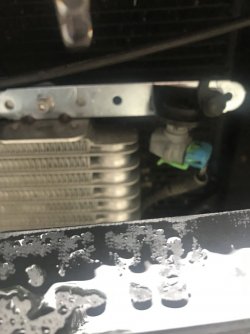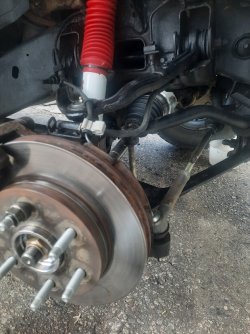Yesterday, I finally found the time and the weather was nice, so I installed the
Tru-Cool - Max LPD47391 47391 Low Pressure Drop Transmission Oil Cooler into the 2003 Avalanche Z-66.
In addition to the transmission oil cooler itself, I had purchased a box of
Derale 13017 Transmission/Engine Oil Hose, a
Hayden Automotive 397 Transmission Line Fitting Kit and a
TRU-COOL TRANSMISSION COOLER BRACKET KIT - 99-07 GM TRUCK from Glenn's Auto Performance.
I've had these parts sitting around for some time now.
Having not previously removed the front grill on the Avalanche, this process was a bit unnerving as I did not want to cause any damage, if possible.
So far, it appears no damage was done, but I plan to reinstall the grill in a day or two after I make sure the cooler installation is leak free.
If everything goes well and I can get the grill back on with no drama, then I will call this installation a win.
So far, so good.
With the cooler bracket kit, this installation could not have gone much easier.
The bracket kit is well designed and complete.
I highly recommend anyone doing this install to plan on purchasing this kit.
Using the supplied parts from the cooler kit and the bracket kit, I only had to come up with some zip ties to complete the installation.
One modification I did was I used one of the supplied brackets from the transmission cooler kit to relocate the ambient air temperature sensor to a new location.
The cooler bracket kit comes with a lower mounting bar that replaces the entire lower brace for the radiator support that normally is the location for the ambient temperature sensor and that factory bracket is discarded.
I used one of the unused mounting brackets that came with the transmission cooler kit and made a couple of notch cuts to the bracket to accommodate a couple of small bumps on the upper left mounting bracket on the cooler, to provide a place to relocate the sensor.
I also used my Dremel to grind off a small spot on the rear of the hood release lever to provide additional clearance between that lever and the top of the transmission cooler.
I could probably have gotten away without that grinding, but I felt it was better to be safe than sorry.
The bracket kit comes with all of the brackets, bolts, washers, nuts and standoffs needed to properly mount the cooler and accommodate the power steering cooler bracket and bolt.
One tip I found helpful was plan to use a Sharpie to mark the exact location of the hood release bracket and remove that bracket to allow for better access to insert and mount the transmission cooler.
Things get too tight to slide the cooler into place once the hose barb fittings are installed on the cooler and those barbs should be installed before mounting the cooler.
You should use care to make sure you do not twist around anything concerning that cooler.
And MAKE SURE you use TWO wrenches to install the hose barb adapters onto the cooler and don't smash them down.
Don't put any undue pressure on the ports of the cooler.
I saw a couple of Youtubes where the installer just smashed down on the barb adapters and ended up ruining their cooler.
The instructions clearly warn of this.
While the instructions for the cooler indicate you can mount the cooler with the ports in any possible orientation, I chose to mimic the factory cooler orientation that I have on my EXT, with the ports on the bottom.
This appears to also be the preferred orientation from the cooler manufacturer, so I will go with that, as well.
They mention something about possible debris settling in the bottom of the cooler if it is mounted with the ports upwards or something like that.
What I know?
I used the Hayden line fitting adapter to connect to the upper radiator cooler port to route the transmission fluid leaving the radiator cooler to the Tru-Cool and then ran a hose back to the transmission return line.
This also appears to be the manufacturer's preferred method and that is how the factory aux cooler is routed on my EXT.
Good enough for me.
A tiny shot of WD-40 on my finger and then applied to each of the barbs and onto the transmission cooler return line helped in getting the hoses fully installed.
Mounting the hose on the transmission return line was a bit of a chore and care was used to not bend or damage the existing line.
Just spray a tiny shot of WD-40 onto the line and into the end of the hose to help with the installation.
I managed to slide the hose about an inch and a half onto the end of the return line.
Plenty of room to install the hose clamp behind the return line barb.
The cooler manufacturer also states in the instructions to not double hose clamp, so that is what I did.
The box of hose I bought provided plenty of hose to route the supply and return hoses just like I wanted.
I routed both hoses past the lower part of the right side radiator flap without having to cut anything.
The a/c lines run in this same area.
Once installed, I zip tied both hoses to secure them from moving around or contacting anything that could do damage.
I also would like to suggest that you plan to go ahead and remove the entire air cleaner box to allow for easier access.
So, with the install complete and everything except for the grill buttoned up, I ran the engine and shifted through the gears then checked and topped off the transmission fluid.
I ended up adding exactly one quart of transmission fluid to accommodate the added capacity of the cooler.
Driving around town produced no leaks and the transmission temperature stayed very low.
With warmer weather predicted and a couple of freeway trips coming up soon, I hope to get a good reading on what to expect.
In reality, with the age and mileage of this transmission, I am just waiting for it to need a rebuild.
My plan was to have the cooler in place when the new rebuild is installed to help protect that one.
But, I had the time and equipment so I figured it could not hurt.













